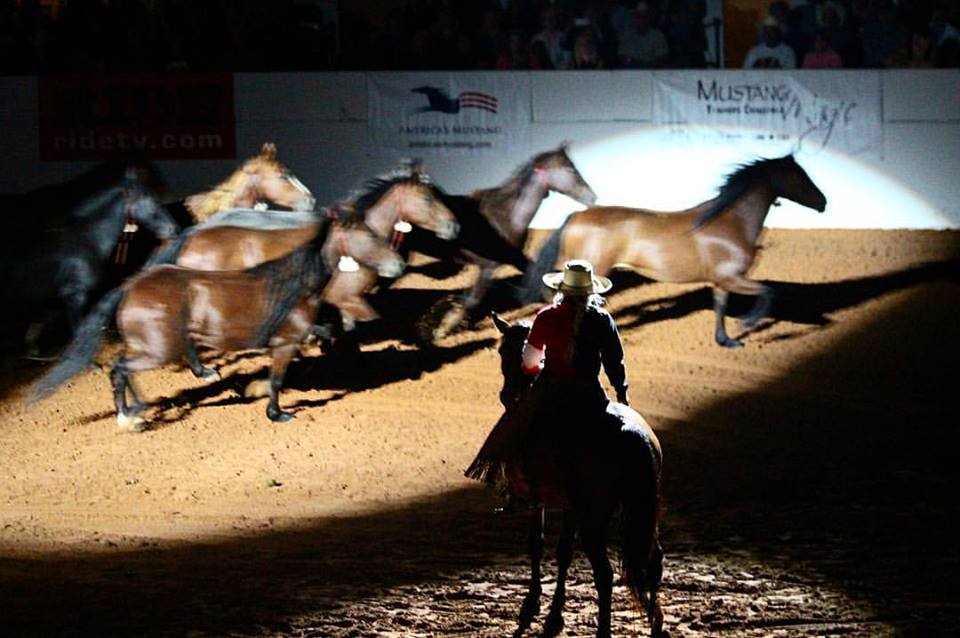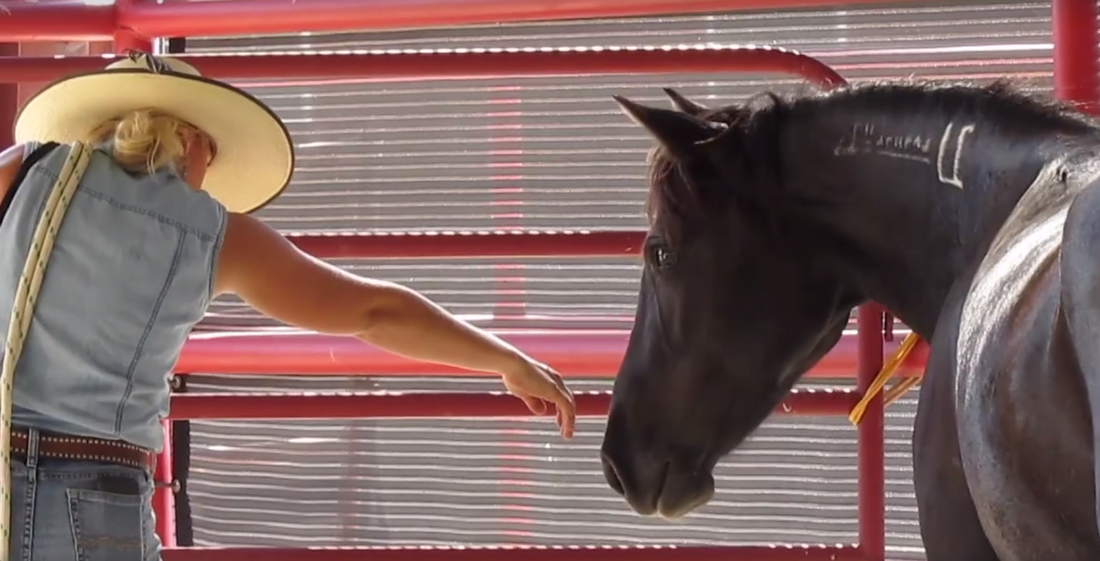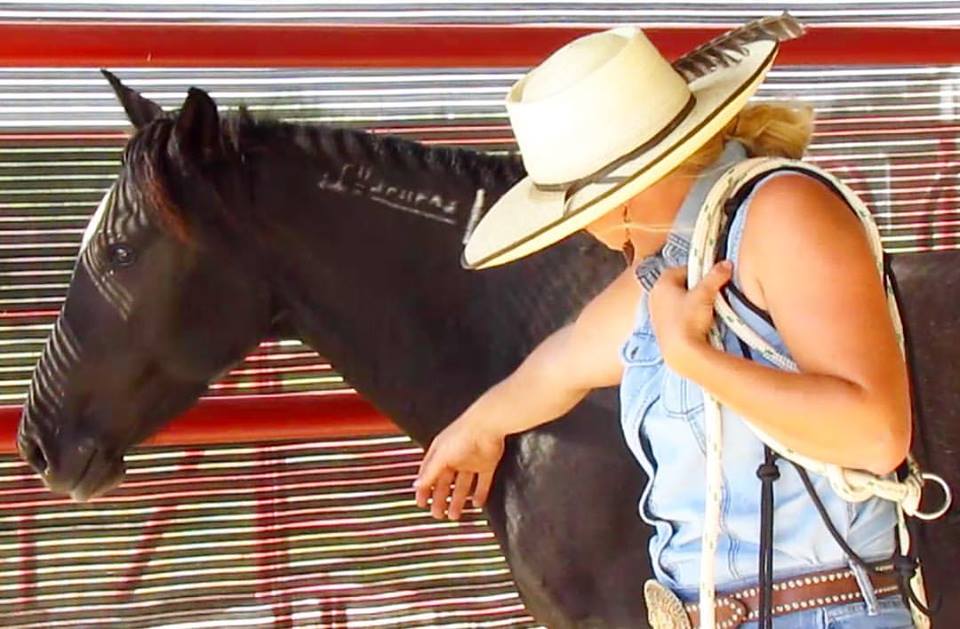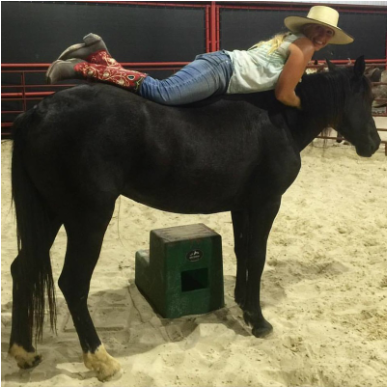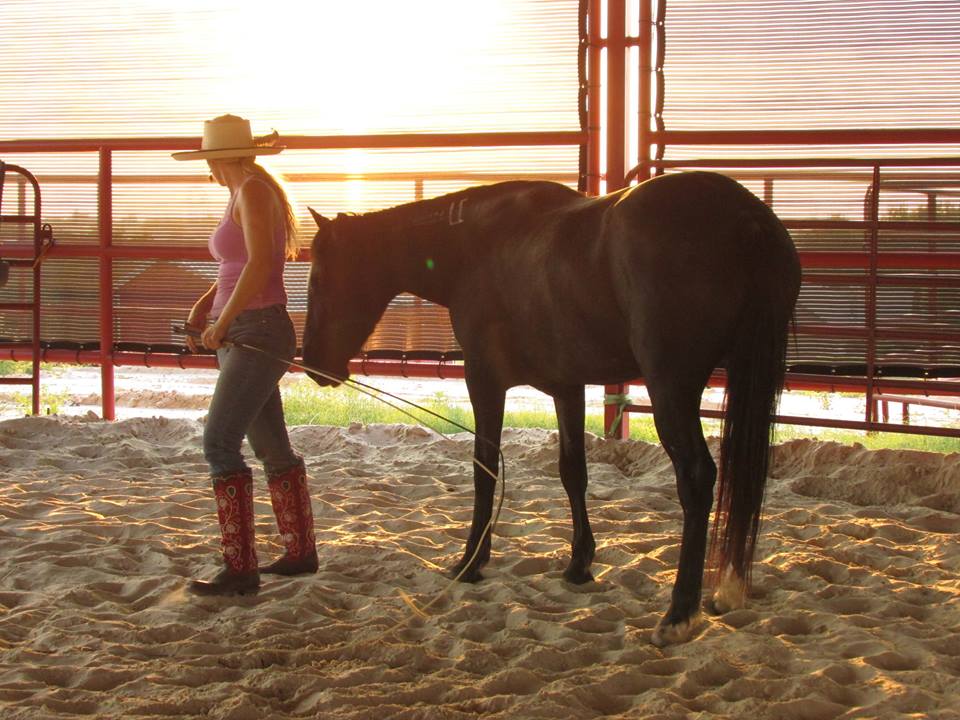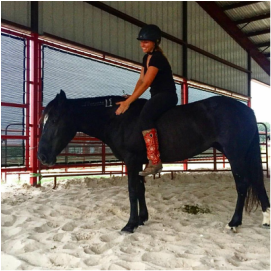|
|
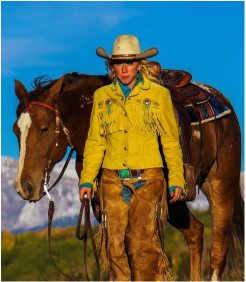
MADISON SHAMBAUGH
Madison Shambaugh is a 22-year-old horsewoman from Fort Wayne, IN and Telluride, CO. She specializes in gentling and training wild horses and exotic equines, with a focus on liberty and bridleless riding. Her involvement with the American Mustang has earned her the nickname, “Mustang Maddy.”
Madison took a deep interest in equine behavior from a young age. She began starting colts and training horses for the public as a high school student and in 2013 she trained her first untouched mustang. In 2015 she participated in the VA Extreme Mustang Makeover with a Mustang she called, “Terk,” who she later adopted. Here she earned the titles of Rookie Champion, Young Guns (Youth) Champion, Fan Favorite, and Overall Reserve Champion. Madison and Terk’s dazzling bridleless freestyle after just 100 days of training captured hearts around the world. Later in 2015, Madison was named the Colt Starting Challenge USA Champion Trainer at Durango, CO. She also took on the most challenging of equines, by starting a young zebra she calls “Zena." Currently, Madison is realizing her dream of an all zebra liberty team, but new addition baby "Zimbee" and soon to join baby "Zeus".
Madison will be touring across the United States and Canada in 2017 with her liberty team of 4 previously wild Mustangs, "Zena" and baby "Zimbee", both zebras, to share her unique training approach that has proven successful across species. For more information on Madison’s schedule, you can visit http://www.madisonshambaugh.com/.
Madison Shambaugh is a 22-year-old horsewoman from Fort Wayne, IN and Telluride, CO. She specializes in gentling and training wild horses and exotic equines, with a focus on liberty and bridleless riding. Her involvement with the American Mustang has earned her the nickname, “Mustang Maddy.”
Madison took a deep interest in equine behavior from a young age. She began starting colts and training horses for the public as a high school student and in 2013 she trained her first untouched mustang. In 2015 she participated in the VA Extreme Mustang Makeover with a Mustang she called, “Terk,” who she later adopted. Here she earned the titles of Rookie Champion, Young Guns (Youth) Champion, Fan Favorite, and Overall Reserve Champion. Madison and Terk’s dazzling bridleless freestyle after just 100 days of training captured hearts around the world. Later in 2015, Madison was named the Colt Starting Challenge USA Champion Trainer at Durango, CO. She also took on the most challenging of equines, by starting a young zebra she calls “Zena." Currently, Madison is realizing her dream of an all zebra liberty team, but new addition baby "Zimbee" and soon to join baby "Zeus".
Madison will be touring across the United States and Canada in 2017 with her liberty team of 4 previously wild Mustangs, "Zena" and baby "Zimbee", both zebras, to share her unique training approach that has proven successful across species. For more information on Madison’s schedule, you can visit http://www.madisonshambaugh.com/.
HOLD ON THE HALTER
by Madison Shambaugh
|
Madison Shambaugh meeting her Mustang Magic 2017 mare, Amira
|
My knuckles are white as I grip the rusty round pen panel, my eyes fixed on the scene before me. I watch eagerly as a BLM worker sorts a scraggly looking black mare out of a herd of Nevada mustangs. She darts out of the pen and into the chutes. Bang. The gate shuts and she is herded down the alley into the stocks. Another bang. She snorts loudly, her eyes wide.
“Do you have a halter you want me to put on her?” The BLM worker asks me. Shoot, I muttered to myself. I knew I was forgetting something. “No, it’s fine…I forgot one.” Generally, once the mustangs are in the stocks and about ready to load into your trailer, BLM staff will put a halter on the horse. Sometimes people even put a halter with a lead attached on the animal. This is generally believed to speed up the gentling process. Prior to this experience, I had done the gentling both ways; halter and no halter. It wasn’t until I worked with this little black mustang, Mustang No. 1236, that I truly realized the benefits of ditching the halter. But back up to September 17th, the day of picking up “Amira” as I would come to call Mustang No. 1236, and I was kicking myself the whole drive home. |
|
“I can’t believe I forgot to bring her halter,” I told Hannah, my co-pilot, as we drove Amira back to where we’d be staying that week. I was in a hurry to get this mustang gentled, leading, and loading not just because I was doing a competition that only allows 100 days of training, but because of another rush as well— I had to get this horse tame enough to haul 1,000 miles back up north a week later to our next stop. I travel full time with 4 performing mustangs and a zebra named “Zena,” and we were nearing the end of our tour. Amira had to be gentled enough to load and haul by the next week.
Usually, if I have a halter put on the mustang at the time of pick-up, I am teaching them to lead that first day. Sometimes I even get on their backs that first day. Had I gone that route, I would’ve been certain my deadlines would’ve been met with ease. But now, who knows. We got back to our host’s home, where we would be staying, and unloaded Amira into a round pen. She trotted out into the pen with ease, blowing a little, but mostly relaxed. We gave our host some feeding directions and said we’d return in the morning with the rest of my team, as I had to return to where we had picked her up for a performance that night. |
Madison's performance at the Extreme Mustang Makeover - Forth Worth, TX Opening Ceremony. Riding her mustang Terk at liberty with a herd of ungentled wild horses for the Mustang Magic 2017. This was truly a magnificent testimony to her bond with her own once wild horse, Terk.
|
|
It’s now Sunday afternoon and the sun is beating down on my shoulders as I walk to the covered arena, where Amira is situated in her round-pen. The humidity suffocates me and I trudge through the sand, back to her pen. I pick up a pitch fork and begin scooping up a pile of manure. This motion sends Amira to the opposite end of the round pen and she snorts, her eyes wild. I finish cleaning her pen and begin working with her. I approach her shoulder, my body tipped to the side, as to avoid approaching her face on. This stance is much less threatening, and I shuffle towards her until I am about 20 feet away. I notice her body tense up as she prepares to go into flight, so I stop and retreat before she moves. I turn my back to her and walk as far as I can away from her. Turning my back helps to reverse the prey-predator relationship we have. As far as she knows, I am her predator. But every time I approach her and then retreat (key word here being retreat), I gain a little bit of her trust, because a predator does not walk away from its prey. Many people believe that rubbing and touching the horses is what gains trust; but it’s actually the retreat that builds trust because of this role reversal that it causes. Another mistake is thinking of pressure only in physical terms; a tapping on the hip, a tightening of the reins, the roll of spur. Pressure can be just as much mental as it is physical. In this situation, I was no where near touching Amira; but she felt the mental pressure of me being closer than what was comfortable. Horses learn from the release of pressure; so every time I release this mental pressure, and walk away, I am rewarding her for standing still and accepting me approach her rather than go into flight. |
I continue this exercise. The next time I approach her an extra step. Again her body tenses, and I retreat. Then I approach yet another step closer. Too much pressure. She goes into flight. I encourage her to continue moving, staying behind her drive line. I let her go a few times around the round-pen, then I step in front of her shoulder. She slows. As soon as she looks at me, I turn and walk away, rewarding her. Then, I start over again. One, two, three steps towards her. She tenses. I turn and back off. I continue this exercise until I am an arms length away. She is learning it is much easier to stand still than it is to leave. If she leaves, she must expel precious energy that needs to be reserved for serious threats. As a prey animal, wasting such energy is avoided whenever possible.
|
I ever so slowly lift my hand towards her an inch. I drop it back down and retreat. Again, same thing. But this time, I lift my arm a few more inches, and retreat. Repeat. Now my hand is outstretched and I lean towards her, resembling another horse stretching his neck towards her to touch noses, careful to keep his space. At first she tips her nose away, into the panel. But then, for a flicker of a moment, she tips her nose towards me. I instantly drop my hand and retreat. Repeat. A few times later, she learns to look to me to get her release of mental pressure. Now she is searching for my hand. It’s so tempting to reach out and touch her. But I know if I do, I will lose all the trust I have built thus far and send her running to the other end of the pen. We are always in a hurry, aren’t we? We live in a world where efficiency is key. But efficiency doesn’t work in building relationships— whether it be with humans or horses. Slow is fast and fast is slow. I drop my hand, retreat, and approach again. This time I feel the breath of her nostrils on my hand and a single whisker brushes my fingertip. Again, I instantly drop my hand and retreat, but this time, there is a big smile on my face. Nothing replaces the feeling of that “first touch.”
|
She gets familiar with this exercise and is consistently searching for my hand now. When she touches it, I back off. I do this exercise until she no longer searches for my hand. At this point, I know that the reward—me walking away— is no longer enough of a motivator for her to reach for me. This means that she is more comfortable with me in her space. So now, I will begin to initiate the touch by rhythmically moving my hand up to her wither area, successively getting closer each try. But it is important she is the one who first initiated touch before moving to this exercise. The prey animal must first initiate touch; then the predator may do so. At least, that is my theory in developing trust in equine-human relationships, a unique partnership between predator and prey.
I ever so gently brush the back of my hand against the tip of her hairs and retreat instantly. I continue this, building it successively until I am rubbing her and she is accepting my touch. Her eyes begin to soften and she is accepting me. She cocks a back leg and takes a deep breath out. Her skin relaxes underneath my hand. For the first time, she begins to understand this world of humans. This is just the beginning of our relationship together and we have a long way to go; but for today, it is a big step forward.
I ever so gently brush the back of my hand against the tip of her hairs and retreat instantly. I continue this, building it successively until I am rubbing her and she is accepting my touch. Her eyes begin to soften and she is accepting me. She cocks a back leg and takes a deep breath out. Her skin relaxes underneath my hand. For the first time, she begins to understand this world of humans. This is just the beginning of our relationship together and we have a long way to go; but for today, it is a big step forward.
|
After this session, I decided to challenge myself and see just how far I could get with no halter… I was already behind other competitors, so why hurry it? I could experiment and see how far I could get that first week with no halter. She ended up getting much further then I actually expected that first week; In fact, by the end of week 1, Amira was riding without ever even wearing a halter or any kind of rope around her for that matter. She was stopping, backing up, leg yielding, pivoting, and riding through the full range of motion. She was trotting figure eights and on the ground, was circling me at liberty and mirroring my steps. (Watch video here: https://www.facebook.com/MadisonShambaugh/videos/vb.456674984355760/1208304352526149/?type=2&theater). And it all started with one silly, seemingly careless mistake of forgetting my halter. |
|
Now, I’m not saying you have to take it as far as I did and advance this far with no halter. What I am saying, is this: look at the possibilities without one! The point of such a liberty start is not to avoid halters, bridles, and ropes altogether; but rather to ease the horse’s transition into such tools. Allowing the mustang to back off and go into flight if they feel they need to is understanding and respecting their fear and their bodies. I want the mustang to accept me by her own free will, not because she is being forced to through a physical tie, or halter. You can apply this to human-human relationships as well. We don’t like being forced or rushed into a relationship either. Furthermore, this approach is all about working with the horse’s nature rather than against it. Rather than preventing them from going into flight, allow them to do so and they learn not to expel such precious energy.
|
You can watch and learn more about my “liberty start” with Amira through a series of episodes being released weekly here:
www.Vimeo.com/ondemand/mustangmaddy |
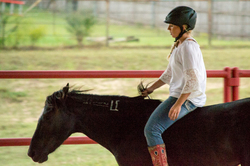
Beginning the gentling process with no halter may take a little longer in the beginning; however, the time spent in the beginning is not time wasted. I think of it like depositing money into my savings account. At first, yes it will cost you. But the dividends it pays later on makes it entirely worth it. The exercises I introduced in this first session will serve as a basis for ground tying, liberty performances, catching, and much more. It is our human nature to rush things and get in a hurry. We want to see results! But you cannot rush relationships. By showing the mustangs that you are a good place to be and establishing a mental connection before a physical one, you will reap dividends in the end.


